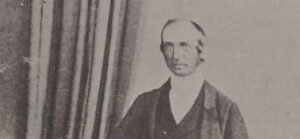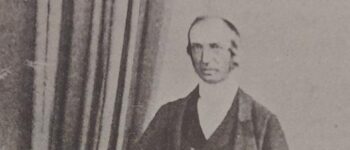1841: Otawhao Mission
May 17, 2023
By AHNZ

Between 1845 and 1860 Te Awamutu had emerged from the dim dark ages of barbaric cannibal wars to a Golden Age of peace and progress. The architect of this Anglo-Maori Utopia was Reverend John Morgan of the Christian Mission Society. He had great expectations for making something out of ‘his’ Maoris just as, equally, those Maoris intended to make good use out of Morgan.
Bloody Otawhao, the birthplace of the great slaughtering warlord (later King) Potatau Te Wherowhero, was split into to rival pa sites; Pagan and Christian. It was a bastardised Christianity cobbled together by incomplete gleenings¹ in their own chapel. But the church bell and the texts were looted from other tribes in raids! Chief Makorau, scourge of the Arawa people, had petitioned for a mission as early as 1834 and John Morgan was there to help clear the land and errect the buildings. However, things took a more ‘inspired’ turn in 1839 when the Maori Christians watched 60 packs full of Rotorua Maori meat be unloaded and cooked in Otawhao ovens by the heathens. To compete with such geat results as these they were going to have to put some effort in so called out for some Anglican Support.
“Maori Christians in July 1839 after they observed Tainui warriors, who had been fighting at Rotorua, return with 60 backpacks of human remains and proceed to cook and eat them in the Otawhao Pa.” – A Lone Hand in Cannibal Land James Cowan The New Zealand Railways Magazine, Volume 9, Issue 6 (1 September 1934) NZETC; Wiki
“This simple implement was indirectly responsible for the deaths of approximately 60,000 Maori. Before the plough, Kumara, which were sacred, could only be planted by men of rank, with nothing more than the Ko to till the soil. After the plough any body, including slaves and women could till the soil to grow potatoes. Potatoes grown by the tonne bought muskets, muskets fuelled the wars 1805-1845. Such were the unintended consequences of the Rev John Butler ‘feeding and civilising the Maori'” – Don Jacobs, Comment to AHNZ (2023)
“By the 1850s Te Awamutu was a Promised Land made real” – Barber (1984)
“Morgan, more than most CMS missionaries, strove to give his Māori converts ‘the comforts of small English farmers’. Morgan envisaged ‘Each family with their neat boarded cottage, surrounded by their orchards and wheatfields, the men employed in driving their Carts,…their women…engaged with their sewing,…training their children in the habits of honest industry.’ His vision was expressed as a romantic idyll.” – Te Ara
 Rev. John Morgan became the permanent missioner to Otawhao on 2 January, 1841. He was one of those men not content to have just one spciality in life but to have a great purpose. Within the consciously educated mind of a civilised person there are multitudes of skills and disciplines; A massive walking library of civilisation. How to fight, how to farm, how to love, how to fix machines. How to finance, how to make contracts, how to plan, how to be numerate and literate, how to worship, how to motivate, how to grieve, how to heal, and on and on. Most men are content to pick one calling and leave the rest unexpressed. For example, in the C20th, Rewi Alley could have been just another Canterbury farmer but instead took his otherwise latent repository of Western Civilisation to China and bestowed it upon them. Morgan did the same thing for the Maoris around Te Awamutu.
Rev. John Morgan became the permanent missioner to Otawhao on 2 January, 1841. He was one of those men not content to have just one spciality in life but to have a great purpose. Within the consciously educated mind of a civilised person there are multitudes of skills and disciplines; A massive walking library of civilisation. How to fight, how to farm, how to love, how to fix machines. How to finance, how to make contracts, how to plan, how to be numerate and literate, how to worship, how to motivate, how to grieve, how to heal, and on and on. Most men are content to pick one calling and leave the rest unexpressed. For example, in the C20th, Rewi Alley could have been just another Canterbury farmer but instead took his otherwise latent repository of Western Civilisation to China and bestowed it upon them. Morgan did the same thing for the Maoris around Te Awamutu.
Unlike other stories like these this time the endevour worked out very well. Morgan, married as he was to one of Rev. Henry Williams’ daughters, knew the history of Missions that failed and learned from their mistakes. Now came modern aggriculture to the Waikato: Horses, oxen, ploughs, drays, flour mills. Comfortable thatched houses, shady groves of peach and apple trees. Ploughs, tools, medicine, wheat, maize, potatoes, kumara. Contracts, literacy, bread, suprplus goods. Prosperity. Morgan, with encouragement and resources too from Governor George Grey, gave his Maoris what they had summoned him to provide and beyond anything they could have hoped for. They had made the leap out of barbarism into civilisation and wealth.
 For a generation Otawhao and Rangiaohia thrived. Surplus goods were taken by river networks to Auckland, Sydney, even California. The humble little stone age people were able to grow their operation and bring back goods from the outside world. Clothes, blankets, tea, sugar, and all kinds of European goods moved along a sort of ‘silk road’ between Te Awamutu and Auckland. Te Awamutu area Maoris were not just doing well in their church and their business they were supreme. Some were coming of age who didn’t know life any other way and never knew the poverty and murder Morgan had liberated them from. “Village gossip no longer revolved around warfare but revolved instead around crop returns.” notes Barber.
For a generation Otawhao and Rangiaohia thrived. Surplus goods were taken by river networks to Auckland, Sydney, even California. The humble little stone age people were able to grow their operation and bring back goods from the outside world. Clothes, blankets, tea, sugar, and all kinds of European goods moved along a sort of ‘silk road’ between Te Awamutu and Auckland. Te Awamutu area Maoris were not just doing well in their church and their business they were supreme. Some were coming of age who didn’t know life any other way and never knew the poverty and murder Morgan had liberated them from. “Village gossip no longer revolved around warfare but revolved instead around crop returns.” notes Barber.
All good things must come to an end. Village gossip, in the end, shifted again from business to politics. Morgan was there when the ageing Te Wherowhero became Maori King in 1858. It was made possible by the food and the money of Rangiaowhia. Morgan moved to speak but was cut off by one of the heathen priests to the effect that Egypt (Britain) was now forsaken and Maoris would follow their own path now like the Jews of old. The signs keep on coming that the now-empowered natives did not want to be part of the Crown Colony of New Zealand that had nurtured them. Morgan reported this feeling back to Auckland and was branded “Reverend Spy” for it but at least he wasn’t killed as others were. In March 1862 Morgan and his family was evicted and land confiscations followed- the Mission was no more. What Morgan had created was now used to threaten Auckland and the New Zealand Settlers. His choice was to remain involved the only way he could- a chaplain in the forces sent to invade the Waikato.
Tragically, the garden paradise of Rangiaohia became an obvious war target since it was the major supply to the King’s army. The natives didn’t bother to defend it and it was destroyed in a fraction of the time it took Morgan to make it. Ref. 1864: Rangiaohia, AHNZ
Poor Morgan. His great miscalculation was that giving Maoris power would influence them into being loyal, Christian, British subjects like himself. Perhaps that gratitude and a feeling of obligation would ease the way to peaceful co-existence and dismiss the urge every people feels for autonomy in its own destiny? No matter how many peaches and surplus bread they grew it was not enough to take on the British war machine. The natives success apparently went to their heads and they picked a fight that ended up destroying them and, no doubt, breaking their ‘fathers’ heart.
—
1 Ref. W.R. Wade in Fronteir Town- A History of Te Awamutu, Laurie Barber (1984)
Image ref. John Morgan. The Old Fronteeir, James Cowan (1922)
Ref. 1864: The Old Man of Rangiaohia, AHNZ
Ref. 1864: Rangiaohia, AHNZ
Note: Before Te Awamutu closed down (2022) they displayed a panel about Thomas Power, Aggricultural Instructor. He had multiple Maori wives and appears to have been one of those ‘Pakeha Maoris’ who lived a hybrid life of the native but with added technological know-how. Power, and others like him, would also have responsibility for the productivitiy boom of Te Awamutu’s Golden Age. I wrote to the museum to learn more without reply because, I’m afraid, they’re not really in the museum game any more. Ref. 1936: Te Awamutu Museum
3 thoughts on "1841: Otawhao Mission"
Leave a Reply
 Like Comment Share
Like Comment Share






Great stuff, I enjoyed the read!
Thanks, news to me and very interesting.
Thanks guys. I wrote to Te Awamutu museum asking if any artifacts were left of these Golden Times. Tools? Old hat or a bible? Seems not and besides which the museum is not a museum now. If there were anything like that it’s in mothballs. Will write about this in due course as well!